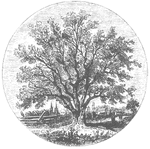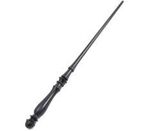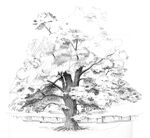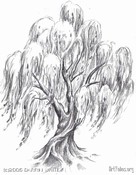The Art of Wandlore:List of Wand Woods
Welcome, on this page I will be teaching you the powers of different woods
Acacia
The Acacia wood is a very one difficult to match. This wand wood will refuse to perform magic for a Witch/Wizard who is not its master. This wand also does not work to its full potential except in the hands of those very gifted in the art of magic. Owners of this wand wood are subtle Witches/Wizards, and so many wand makers only keep a small supply of this wood.
Alder
Alder is an unyielding wood, but this does not make the owner stubborn or obstinate, rather a generally helpful, considerate and most likeable person. Alder wands are better with non-verbal spells, but can only do this when paired with a Master Witch/Wizard.
Apple
This wand wood is not made for many. This wand is usually paired with an owner of high aims and ideals, and works poorly with the Dark Arts. It is said that the possessor of an apple wand will be well-loved and long-lived. This wand bestows the strange ability to converse with other magical beings in their native tongues.
Ash
Ash wand are as loyal as hounds - this is why in the wand master community they are referred to as Dogs' wands. These wands must never be passed on and will only work for their original master. This wand wood is also stubborn; in this nursery rhyme we see the evidence,'rowan gossips, chestnut drones, ash is stubborn, hazel moans'.
Aspen
Aspen wands are particularly adept at healing spells. This wand is also high prized by wand makers for its white coloration, which closely resembles ivory. This wand is usually owned by Wizards/Witches who are skilled duellists.
Beech
The most important thing about a Beech wand is that they perform very weakly for the narrow-minded and intolerant.The beech wand is capable of a subtlety and artistry rarely seen in any other wood, if matched with the right partner.
Blackthorn
Other names for this wand wood are Warrior Wood and Weapon Wood. As you may have guessed, this wand is a warrior's wand - this could mean a fighter or a brave person with a fiery attitude. This does not mean that this wand is intrinsically evil, as it works well for many famous Aurors as much as for denizens of Azkaban. This wand wood is very loyal.
Black Walnut
This wand wood is less common than its sister wood, the Walnut. This wand seeks a wielder with good instincts and powerful insight. Black walnut is a very handsome wood, but it is nearly impossible to master.
Cedar
Carriers of this wood wand are usually loyal, and have strength of character. There is a saying amongst wandmakers and masters, 'you will never fool the cedar carrier' which is true. The witch or wizard who is well-matched with cedar carries the potential to be a frightening adversary, which often comes as a shock to those who have thoughtlessly challenged them.
Cherry
This is a very rare wand wood indeed. Most highly prized by the students at Mahoutokoro School in Japan, those who carry it have very mysterious prestige. This wand wood is best paired with the Dragon Heartstring core. This wand ought never to be teamed with a wizard who lacks exceptional self-control and strength of mind.
Chestnut
This wand wishes to be partnered with tamers of beasts such as Dragon tamers or breeders. For this reason they are sometimes called critter's wands and barbarian's.When paired with Dragon Heartstring, chestnut wands may find their best match among those who are hedonistic, overfond of luxury and material things
Cypress
In the Medieval Era this wand was always paired with Witches/Wizards who were to die heroic deaths. Fortunately, in these less blood-thirsty times, the possessors of cypress wands are rarely called upon to lay down their lives, though doubtless many of them would do so if required.Wands of cypress find their soul mates among the brave, the bold and the self-sacrificing.
Dogwood
This wand is one of a playful nature, and it is likewise far-out and mischievous. It wishes to be partnered with Witches/Wizards who will provide it with a fun life. Dogwood wands are known for casting outstanding spells under great pressure, and when matched with a clever partner they can perform dazzling spells.
Ebony
This wand has a hue that is black as jet. This wand has an impressive appearance and reputation. This wand is gifted in combative magic, and for Transfiguration. This wand is happiest in the hands of people who are happy with themselves.
Elder
This is the rarest wood of all and is apparently extremely unlucky. Wands of this wood contain powerful magic, but scorn to remain with any owner who is not the superior of his or her company.‘Wand of elder, never prosper' is a saying that shows how much Witches/Wizards fear a wand of Elder. This superstition is baseless, and those foolish wandmakers who refuse to work with elder, do so more because they doubt they will be able to sell their products, than from fear of working with this wood.
Elm
The unfounded belief that only pure-bloods can produce magic from elm wands was undoubtedly started by some elm wand owner seeking to prove his own blood credentials. There are many Muggle-borns who do, in point of fact, own an Elm wand. Elm are known for their low risk magic and are the ones which produce the fewest accidents. In the right hands, they are capable of highly advanced magic.
Fir
This wand wood is sometimes also called ‘the survivor’s wand,’ because three wizards who have bought this wand have passed through mortal peril unscathed. There is no doubt that this wood, coming as it does from the most resilient of trees, produces wands that demand staying power and strength of purpose in their rightful owners.
Hawthorn
This wand wood is complex and intriguing in its nature, just like the owners who best suit it. This wand is sometimes called the doctor's wand or wand of health for it is gifted in healing magic, but also adept at curses. Hawthorn is not easy to master, however, and one should only ever consider placing a hawthorn wand in the hands of a witch or wizard of proven talent, or the consequences might be disastrous.
Hazel
A sensitive wand, it mostly imitates its master's emotions. It works best with a master that can control their own state of mind. Sometimes called a Draught Wand or Water Wand, for Hazel wands also have the unique ability to detect water underground, and will emit silvery, tear-shaped puffs of smoke if passing over concealed springs and wells.
Holly
Holly is a rarer kind of wand wood, less cultivated by foresters. It is happier with wielders who may need help overcoming a tendency to anger and impetuosity. This wand wood is perilous to partner with a phoenix feather's core, yet, in the unusual event of such a pairing finding its ideal match, nothing and no-one should endeavour to stand in their way.
Hornbeam
Hornbeam selects for its lifemate the talented witch or wizard with a single, pure passion, which some might call obsession - more kindly - vision, which will almost always be realised. This wand is the quickest to adapt to its wielder's kind of magic. Hornbeam wands likewise absorb their owner’s code of honour.
Larch
Strong, durable and warm in colour, larch has long been valued as an attractive and powerful wand wood. This wand is hard to place with a good owner, for it yearns for rare magic. This much sought-after wand is, however, hard to please in the matter of ideal owners, and trickier to handle than many might imagine.
Laurel
It is said that a laurel wand cannot perform a dishonourable act, although in the quest for glory (a not uncommon goal for those best suited to these wands), laurel wands have been known to perform powerful and sometimes lethal magic. Otherwise, it will cleave happily to its first match forever, and indeed has the unusual and engaging attribute of issuing a spontaneous lightning strike if another witch or wizard attempts to steal it.
Mahogany
Not much is known of this wand wood, as it is most seldom used. The sole famous owner of this wand wood was James Potter. His wand was wonderful at transfiguration spells.
Maple
The Traveller's wand or The Explorer's Companion. Given this name, you may easily predict what this wand looks for in a partner. This is a beautiful and desirable wood, and wand quality maple has been among the most costly for centuries. In times long past, carriers of Maple wands were usually high in rank among wizardkind.
Oak
A very friendly wand for the good times and the bad, it will always stick to its first companion. But in their partners wands of English oak demand companions of strength, courage and fidelity. The oak tree is called King of the Forest from the winter solstice up until the summer solstice, and its wood should only be collected during that time (holly becomes King as the days begin to shorten again, and so holly should only be gathered as the year wanes). There is an old folk rhyme that goes like this “when his wand’s oak and hers is holly, then to marry would be folly,”, in which we see how this wand interacts with the holly wand.
Pear
A splendid wand that comes in a golden-toned colour. Sometimes referred to as the wise wand or the wand of plenty, for this wand favours generous, wise and warm-hearted Witches/Wizards. Pear wands are usually carried by respectable Witches or Wizards. Pear wands are among the most resilient, and it is noted that they may still present a remarkable appearance of newness, even after many years of hard use.
Pine
A straight-grained wand that in its partner looks for the independent individual. Pine wands enjoy being used creatively, and unlike some others, will adapt unprotestingly to new methods and spells. The pine wand is one of those that is most responsive to non-verbal magic.
Poplar
There is a saying among wand makers, “If you seek integrity, search first among the poplars." It is said to be a wand to rely upon, of consistency, strength and uniform power, always happiest when working with a witch or wizard of clear moral vision.
Redwood
Called the Irish Wand, Money Wand or even the Lucky Wand, these wand woods are said to bring good fortune to those who wield them. For this, they are in high demand. As is usually the case with wandlore, the general populace have the truth back to front: redwood wands are not themselves lucky, but are strongly attracted to witches and wizards who already possess the admirable ability to fall on their feet, to make the right choice, to snatch advantage from catastrophe.
Rowan
These wands have always been much-favoured. As it is reputed to be more protective than any other, rendering defensive charms especially strong and difficult to break, rowan is most happily placed with the clear-headed and the pure-hearted. This reputation for virtue, however, should not deceive - these wands are the equal of any, often the better, and frequently out-perform others in duels.
Silver lime
Highly fashionable in the 19th century and highly attractive. The reasons for these wands’ desirability lay not only in their unusually handsome appearance, but also because they had a reputation for performing best for Seers and those skilled in Legilimency, mysterious arts both, which consequently gave the possessor of a silver lime wand considerable status.
Spruce
By less competent wand makers this wand is labeled hard but by doing so they reveal their own ineptitude. The spruce wand requires a firm hand, because it often appears to have its own ideas about what magic it ought to be called upon to produce. However, when a spruce wand meets its match - which, in my experience, is a bold spell-caster with a good sense of humour - it becomes a superb helper, intensely loyal to its owner and capable of producing particularly flamboyant and dramatic effects.
Sycamore
The sycamore makes a questing wand, eager for new experience and losing brilliance if engaged purely in mundane activities. As may be deduced, the sycamore’s ideal owner is curious, vital and adventurous. And when paired with such an owner, it demonstrates a capacity to learn and adapt that earns it a rightful place among the world’s most highly-prized wand woods.
Vine
If you know your Wizarding History, then you should know that the druids considered anything with a woody stem as a tree; this, combined with the fact that vine is thought to produce wands of a special nature, means that whilst vines are not actually trees, they continue to be used in the production of wands to this day. Vine wands are among the less common types, and their owners are nearly always those witches or wizards who seek a greater purpose, who have a vision beyond the ordinary and who frequently astound those who think they know them best.
Walnut
Highly intelligent witches and wizards ought to be offered a walnut wand for trial first, because in nine cases out of ten, the two will find in each other their ideal mate.This wand wood has often been found in the hands of great inventors and innovators. This wand can be a truly lethal weapon in the hands of a witch or wizard of no conscience, for the wand and the wizard may feed off each other in a particularly unhealthy manner.
Willow
An ancient and uncommon wand wood with the power of healing. While many confident customers insist on trying a willow wand (attracted by their handsome appearance and well-founded reputation for enabling advanced, non-verbal magic), the willow wands there are have consistently selected those of greatest potential, rather than those who feel they have little to learn.
Yew
Yew wands are among the rarer kinds, and their ideal matches are likewise unusual, and occasionally notorious. Wands hewn from these most long-lived trees have been found in the possession of heroes quite as often as of villains. Where wizards have been buried with wands of yew, the wand generally sprouts into a tree guarding the dead owner’s grave. What is certain is that the yew wand never chooses either a mediocre or a timid owner.
Now read on, and glimpse more secrets about the magical branch of magical Wandlore




